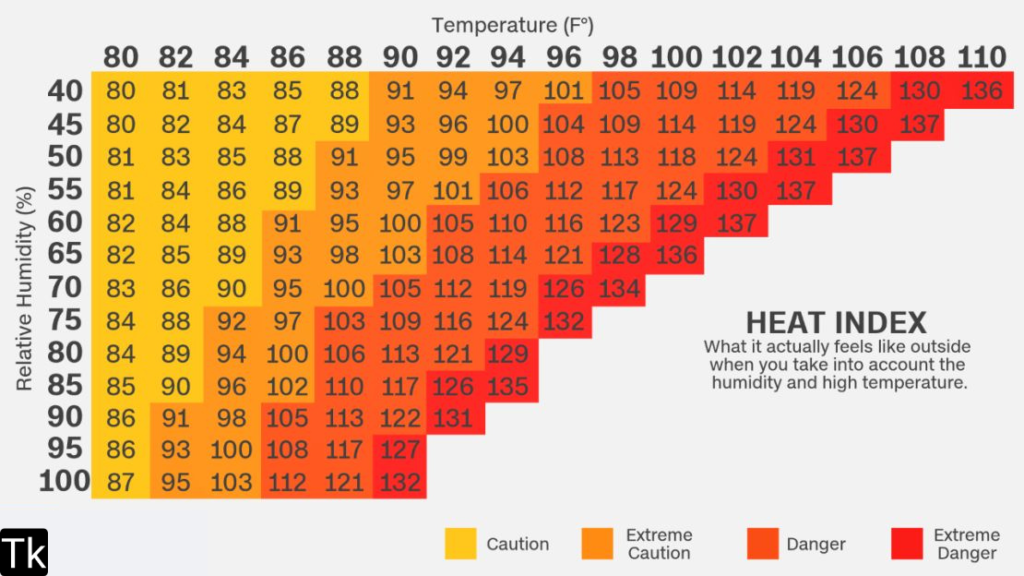🔥 Heat Index Calculator
Calculate heat index value and get safety recommendations
Heat Index: The Ultimate Guide to Understanding and Calculating It
When the mercury rises, it’s not just the temperature that matters—it’s also how that temperature feels on your skin. This perceived warmth is captured by a measure known as the heat index. In today’s world, understanding the heat index is crucial not only for everyday comfort but also for construction safety, outdoor events, and public health. Whether you’re a homeowner trying to beat the summer heat or a safety manager on a construction site, knowing how to calculate and interpret the heat index is key.
What Is the Heat Index?
The heat index is a measure that combines air temperature and relative humidity to determine what the temperature “feels like” to the human body. Even on moderately hot days, high humidity levels can hinder the body’s ability to cool itself by evaporating sweat, making it feel hotter than the actual air temperature. This perceived temperature is why many people refer to it as the “feels like temperature.”
A feels like temperature calculator is an invaluable tool for quickly assessing the risk of heat stress during hot weather. It provides insights that go beyond a standard thermometer reading, taking into account how the humidity intensifies the heat.
Why the Heat Index Matters
Understanding the heat index is essential for multiple reasons:
Health and Safety: When the heat index soars, there is an increased risk of heat-related illnesses such as heat exhaustion and heat stroke. Public health advisories often use the heat index to warn people about dangerous conditions.
Construction Safety: In sectors like construction, where outdoor labor is common, a Heat index calculator for construction safety is critical. It helps ensure that workers are not exposed to dangerous conditions that could lead to injury or illness.
Event Planning: Whether you are planning an outdoor sports event or a community festival, knowing the heat index can help organizers make decisions about scheduling, hydration stations, and cooling measures.
Daily Comfort: Even for those of us in non-industrial settings, knowing the heat index helps in planning daily activities, such as exercising outdoors, running errands, or planning vacations.
How Is the Heat Index Calculated?
The heat index is derived from a complex formula that incorporates both the air temperature and the relative humidity. For those who want to know how to calculate heat index manually, here’s a simplified explanation:
Start with the Temperature and Humidity Values: You need two main inputs—the air temperature (typically in Fahrenheit) and the relative humidity (as a percentage).
Apply the Heat Index Formula: The National Weather Service uses a formula that takes these two variables into account. The standard formula is:
HI = c1 + c2*T + c3*R + c4*T*R + c5*T² + c6*R² + c7*T²*R + c8*T*R² + c9*T²*R²
In this formula, T is the air temperature and R is the relative humidity. The constants (c1, c2, c3, etc.) are derived from empirical studies and have specific values. While the complete equation might look intimidating, many people simply rely on a heat index calculator that automates this process.
- Interpreting the Result: The output is the “feels like” temperature. This value can be significantly higher than the actual air temperature in humid conditions. For example, a day with 90°F might feel like 105°F when humidity levels are high.
- Manual Calculation Simplified: For everyday purposes, some simplified charts and online tools can help determine the heat index without needing to perform the complex calculation manually. However, if you’re curious about how to calculate heat index manually, understanding the underlying relationship between temperature and humidity is a great start.
Heat Index Chart

Integrating the Heat Index in Daily Decision-Making
With the rising importance of heat safety, particularly during the summer months, being informed about the heat index can save lives. It empowers individuals and organizations alike to make data-driven decisions. Whether you’re a safety manager needing to protect workers on a hot day or a fitness enthusiast planning an outdoor workout, using a heat index calculator and understanding its nuances is indispensable.
Conclusion: Embracing Smart Heat Management
In conclusion, the heat index is much more than a mere number. It represents the complex interplay between temperature and humidity, influencing how we feel on even the hottest days. By leveraging reliable tools like the Best heat index calculator and understanding the methods behind the numbers—especially how to calculate heat index manually—individuals and professionals can take proactive measures to stay safe and comfortable.
Whether you’re planning for construction safety, organizing a community event, or simply deciding on your outdoor activities for the day, knowing the heat index helps you make informed decisions. Embrace technology and reliable data, and remember: staying ahead of the heat is not just a comfort issue, but a vital health and safety measure.
Calculator Features Snapshot
Our state-of-the-art heat index calculator not only allows you to quickly calculate heat index values but also offers a feels like temperature calculator that lets users choose between Fahrenheit, Celsius, and Kelvin units. In addition, it provides clear risk level indications and tailored health recommendations to ensure that you stay safe under extreme conditions.
